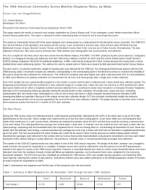
An official website of the United States government
Here’s how you know
Official websites use .gov
A .gov website belongs to an official government organization in the United States.
Secure .gov websites use HTTPS
A lock (
) or https:// means you’ve safely connected to the .gov website. Share sensitive information only on official, secure websites.
-
//
- Census.gov /
- Census Working Papers /
- The 1996 American Community Survey Monthly Response Rates, by Mode
The 1996 American Community Survey Monthly Response Rates, by Mode
The 1996 American Community Survey Monthly Response Rates, by Mode
The American Community Survey (ACS) has been designed and is being tested as a replacement for the decennial census long form. The 1996 ACS was the first full test of the operations and systems for the survey. It was conducted in only four sites, three of them urban (Portland City and Multnomah County, Oregon, Brevard County, Florida, and Rockland County, New York), and one rural (Fulton County, Pennsylvania). The data collected in these four sites were used to estimate their 1996 calendar year demographic and socioeconomic characteristics.
The ACS samples for the three urban sites were drawn from the Master Address File (MAF). The MAF, produced by the Census Bureau’s Geography division, is a merging of housing unit addresses from the 1990 census Address Control File (ACF) and the current United States Postal Service’s (USPS) Delivery Sequence File (DSF) of residential addresses. A MAF could not be produced for Fulton County because the county lacks a house number/street name addressing system. The address list used to sample units in Fulton was created by field personnel hired by the Census Bureau.
For most areas a 15 percent systematic sample of housing units was selected for the 1996 test. For small governmental units (places with less that 1000 housing units) a 30 percent sample was selected, corresponding to the oversampling done in the decennial census to increase the reliability of the census long form data estimates for small places. The 1996 ACS sampling rates were higher than what is planned when ACS is in full production in 2003, but it allowed us to produce estimates of characteristics for all tracts and block groups after a single year of data collection.
Each ACS sample unit was systematically assigned to a test month, or panel, and the data is collected over a three month data collection period. The designated panel dictated when the mail phase of data collection began for sample units. Urban site units not returning an ACS questionnaire within their panel month and for which a telephone number had been obtained from a commercial vendor were included in a Computer-Assisted Telephone Interview (CATI) nonresponse follow-up operation during the second month of data collection. All sample units--urban and rural--remaining uninterviewed after two months were subsampled at a rate of one-in-three and sent to a field Computer-Assisted Personal Interview (CAPI) nonresponse follow-up operation. Because of this unique survey data collection design, ACS has provided considerable insight into response patterns and characteristics of the test site populations for each of the three data collection methods. This paper attempts to describe some of them, and is based on results from the first 12 months of ACS data collection.
Others in Series
Working Paper
Working Paper
Working Paper
Share
Some content on this site is available in several different electronic formats. Some of the files may require a plug-in or additional software to view.
 Yes
Yes
 No
NoComments or suggestions?


Top

